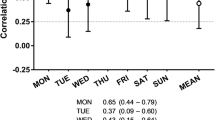Abstract
Few studies have evaluated the reliability of a self-administered current and historical physical activity questionnaire (PAQ) among middle-aged and elderly women. We evaluated the reliability of a self-administered PAQ designed to assess total (24 h) current and historical physical activity at age 15, 30, and 50 years, which was completed by a subgroup of 303 women aged 56–75 years from the Swedish Mammography Cohort (SMC). Total physical activity covered occupational and household activity as well as walking/bicycling, exercise, and inactivity (sitting watching TV/reading). Reliabilities (1-year test–retest) of continuous activity measures in metabolic equivalents were evaluated using an intraclass correlation coefficient (ICC); classification consistency was evaluated using sensitivity and specificity statistics. The ICC for total current physical activity was 0.69; for specific types of activities the ICC ranged from 0.49 to 0.59; for historical physical activity, the reliabilities for total activity ranged from 0.75 for age 50 to 0.81 for age 30 years, being substantial for occupational activities (ICC = 0.73–0.75), and fair to moderate for inactivity (ICC = 0.31–0.60). These data indicate that the PAQ used in the SMC is a satisfactory and reproducible measure of current and historical physical activity, for total as well as for different types of activities.
Similar content being viewed by others
Abbreviations
- PAQ:
-
Physical activity questionnaire
- SMC:
-
Swedish Mammography Cohort
- ICC:
-
Intraclass correlation coefficient
- PA:
-
Physical activity
References
Warburton DE, Nicol CW, Bredin SS (2006) Health benefits of physical activity: the evidence. Cmaj 174:801–809
Chasan-Taber L, Erickson JB, McBride JW, Nasca PC, et al (2002) Reproducibility of a self-administered lifetime physical activity questionnaire among female college alumnae. Am J Epidemiol 155:282–289
Kriska AM, Sandler RB, Cauley JA, LaPorte RE, et al (1988) The assessment of historical physical activity and its relation to adult bone parameters. Am J Epidemiol 127:1053–1063
Friedenreich CM, Courneya KS, Bryant HE (1998) The lifetime total physical activity questionnaire: development and reliability. Med Sci Sports Exerc 30:266–274
Larsson SC, Bergkvist L, Wolk A (2005) Magnesium intake in relation to risk of colorectal cancer in women. Jama 293:86–89
Orsini N, Bellocco R, Bottai M, Pagano M, et al (2006) Age and temporal trends of total physical activity among Swedish women. Med Sci Sports Exerc 38:240–245
Ainsworth BE, Haskell WL, Whitt MC, Irwin ML, et al (2000) Compendium of physical activities: an update of activity codes and MET intensities. Med Sci Sports Exerc 32:S498–S504
Norman A, Bellocco R, Bergstrom A, Wolk A (2001) Validity and reproducibility of self-reported total physical activity–differences by relative weight. Int J Obes Relat Metab Disord 25:682–688
StataCorp (2005) Stata Statistical Software: Release 9. College Station, TX
Greenland S (1996) Basic methods for sensitivity analysis of biases. Int J Epidemiol 25:1107–1116
Friedenreich CM, Courneya KS, Neilson HK, Matthews CE, et al (2006) Reliability and validity of the past year total physical activity questionnaire. Am J Epidemiol 163:959–970
Matthews CE, Shu XO, Yang G, Jin F, et al (2003) Reproducibility and validity of the Shanghai Women’s Health Study physical activity questionnaire. Am J Epidemiol 158:1114–1122
Wareham NJ, Jakes RW, Rennie KL, Mitchell J, et al (2002) Validity and repeatability of the EPIC-Norfolk Physical Activity Questionnaire. Int J Epidemiol 31:168–174
Wolf AM, Hunter DJ, Colditz GA, Manson JE, et al (1994) Reproducibility and validity of a self-administered physical activity questionnaire. Int J Epidemiol 23:991–999
Acknowledgments
This study was supported by Swedish Council for Working life and Social Research (FAS), the Swedish Research Council/Longitudinal studies, World Cancer Research Fund International, and the Swedish Foundation for International Cooperation in Research and Higher Education (STINT).
Author information
Authors and Affiliations
Corresponding author
Rights and permissions
About this article
Cite this article
Orsini, N., Bellocco, R., Bottai, M. et al. Reproducibility of the past year and historical self-administered total physical activity questionnaire among older women. Eur J Epidemiol 22, 363–368 (2007). https://doi.org/10.1007/s10654-006-9102-1
Received:
Accepted:
Published:
Issue Date:
DOI: https://doi.org/10.1007/s10654-006-9102-1




